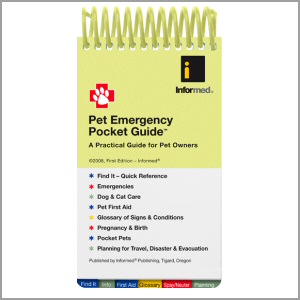An ounce of prevention is worth a pound of cure. Chance favors those who are prepared. My sister always told me to have a plan B and always be prepared. The latter may have emanated from the Boy Scouts, but it was very good advice.
My advice to you is if you have a dog or cat, you need to have emergency supplies on hand. Equally important to having the proper supplies is knowing when and how to use them. You may be surprised to find out that many of the items needed for your pet emergency kit are ordinary household items you may already have. Recognizing the signs your dog or cat may show when ill or injured is half the problem and administrating care is the other half. So, BEFORE an emergency occurs, make a list and make an appointment to talk to your vet.
 The Pet Emergency Pocket Guide™ was written and edited by a team of veterinarians, experts in animal safety, and pet owners and offers advice on planning ahead and locating care for your pets in the event of an injury, illness or emergency. Color-coded, and illustrated sections show and tell you what to do for your pets, before, during, and after an emergency. Some of the categories are, but not limited to: “How-to” first aid, including CPR and Heimlich ● Contact information for important emergency references ● General care, including handling, grooming, muzzling, and transporting ● Glossary of signs and conditions in dogs and cats ● List of the most common poisonous and toxic foods ● Taking care of a sick dog or cat, and more serious condition ● How to create pet emergency and shelter/evacuation kits ● Traveling with your pet, including preparing a travel kit ● Pet preparedness, including planning for natural disasters ● Current information on sheltering, since many shelters do not accept pets ● Pet record pages to help document information such as allergies, vaccinations, and surgeries.
The Pet Emergency Pocket Guide™ was written and edited by a team of veterinarians, experts in animal safety, and pet owners and offers advice on planning ahead and locating care for your pets in the event of an injury, illness or emergency. Color-coded, and illustrated sections show and tell you what to do for your pets, before, during, and after an emergency. Some of the categories are, but not limited to: “How-to” first aid, including CPR and Heimlich ● Contact information for important emergency references ● General care, including handling, grooming, muzzling, and transporting ● Glossary of signs and conditions in dogs and cats ● List of the most common poisonous and toxic foods ● Taking care of a sick dog or cat, and more serious condition ● How to create pet emergency and shelter/evacuation kits ● Traveling with your pet, including preparing a travel kit ● Pet preparedness, including planning for natural disasters ● Current information on sheltering, since many shelters do not accept pets ● Pet record pages to help document information such as allergies, vaccinations, and surgeries.
Detailed information will guide you through injury and medical emergency situations such as car accidents, collapsing or fainting, diarrhea that goes on for more than a day…especially in small animals, distended abdomen, electrical shock, eye injury or swelling, fever, frequent vomiting, frostbite, labor or birthing difficulty, loss of consciousness, neck injury, pale gums, paralysis or lack of coordination poisoning, seizures, straining to urinate and unproductive retching.
I know all of my fellow rescuers have their own brand of provisions put away in a Rubbermaid container in the event that a puppy is hypoglycemic, vomiting to point of dehydration or simply has a tick embedded in their neck. I ‘m going to list a few of the things I keep in my stash and would love it if some of you would e-mail me with a list of yours. OK…Some of the things I have are: a rectal thermometer and Vaseline, tweezers, scissors, bandages, cardboard, Neosporin and triple antibiotic cream and ointment, a bottle of Dawn antibacterial soap, Nol Vasan solution, Preparation H, alcohol, Witch Hazel, peroxide, Pepto Bismol, antibiotic eye ointment, eye drops- non steroidal, Benadryl liquid, Benadryl topical, q-tips, cotton pads, self-adherent bandage wrap, Pedialyte, chicken broth no sodium added, jarred baby chicken puree, frozen chicken cutlets, minute Rice, baby rice cereal, Karo syrup, Esbilac puppy formula, rubber coated baby spoon, insulin syringes without the needles, and an eye dropper bottle.
DISCLAIMER: If your pet experiences a medical emergency, PLEASE CALL YOUR VETERINARIAN OR CLOSEST PET EMERGENCY FACILITY. It is NOT intended or recommended that you treat your pet yourself in lieu of seeking the care of a veterinarian. It is recommended that you meet with your veterinarian and discuss what you may be able to do for your particular pet in the event that a medical problem arises, and immediate veterinary care is not available, or until you reach an emergency clinic.





